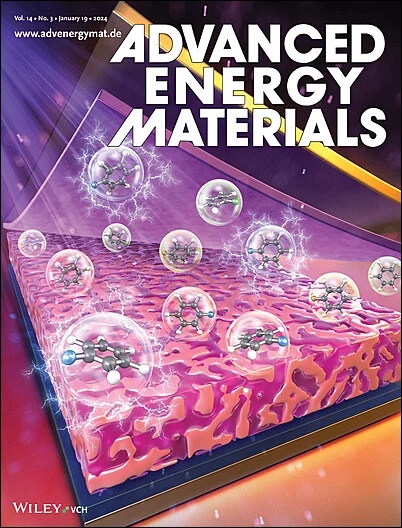非卤化溶剂加工有机太阳能电池,效率超过20.0%,110 cm2模块超过13%,由成膜动力学工程实现
IF 26
1区 材料科学
Q1 CHEMISTRY, PHYSICAL
引用次数: 0
摘要
小面积有机太阳能电池(OSCs)的效率目前已超过20%,而微型组件的效率已超过17%。然而,超过100 cm2的大面积模块的性能仍然落后,这主要是由于精确控制薄膜形成动力学以达到最佳结晶度和纳米形态的限制。在本研究中,相分离和聚合物流变性在薄膜形成过程中进行了协同研究。利用计算流体动力学(CFD)模拟和理论计算,深入研究了大面积模块的膜形成动力学,并提出了热增强快速形态演化策略(HF)。这种方法减轻了大面积薄膜沉积过程中过度的相分离,减少了非辐射复合,增强了载流子输运。使用非卤化高沸点溶剂处理的基于PM1:L8-BO:BTP-eC9的器件显示出20.3%的功率转换效率(PCE),相应的110 cm2(有效面积为100 cm2)模块实现13.1%的效率(认证PCE为12.7%)。最后阐述了有机太阳能电池组件在环保和医疗领域的潜在应用。本文章由计算机程序翻译,如有差异,请以英文原文为准。
Non-Halogenated Solvent-Processed Organic Solar Cells with Efficiencies Exceeding 20.0% and 110 cm2 Modules Exceeding 13% Enabled by Film-Forming Dynamics Engineering
The efficiency of small-area organic solar cells (OSCs) has now exceeded 20%, while mini-modules have achieved efficiencies of over 17%. However, the performance of large area modules over 100 cm2 still lags behind, largely due to the limitation of precisely controlling the film formation dynamics to achieve optimal crystallinity and nanomorphology. In this study, phase separation and polymer rheology are synergistically investigated during film formation. Using computational fluid dynamics (CFD) simulations and theoretical calculations, the film formation dynamics are thoroughly investigated in large-area modules and propose a heat-enhanced fast morphological evolution strategy (HF). This method mitigates excessive phase separation during large-area film deposition, reduces non-radiative recombination, and enhances charge carrier transport. Devices based on PM1:L8-BO:BTP-eC9 processed using a non-halogenated high-boiling point solvent exhibit a power conversion efficiency (PCE) of 20.3%, with the corresponding 110 cm2 (active area of 100 cm2) module achieving an efficiency of 13.1% (certified PCE of 12.7%). Finally, the potential applications of organic solar cell modules in environmental protection and medical fields are demonstrated.
求助全文
通过发布文献求助,成功后即可免费获取论文全文。
去求助
来源期刊

Advanced Energy Materials
CHEMISTRY, PHYSICAL-ENERGY & FUELS
CiteScore
41.90
自引率
4.00%
发文量
889
审稿时长
1.4 months
期刊介绍:
Established in 2011, Advanced Energy Materials is an international, interdisciplinary, English-language journal that focuses on materials used in energy harvesting, conversion, and storage. It is regarded as a top-quality journal alongside Advanced Materials, Advanced Functional Materials, and Small.
With a 2022 Impact Factor of 27.8, Advanced Energy Materials is considered a prime source for the best energy-related research. The journal covers a wide range of topics in energy-related research, including organic and inorganic photovoltaics, batteries and supercapacitors, fuel cells, hydrogen generation and storage, thermoelectrics, water splitting and photocatalysis, solar fuels and thermosolar power, magnetocalorics, and piezoelectronics.
The readership of Advanced Energy Materials includes materials scientists, chemists, physicists, and engineers in both academia and industry. The journal is indexed in various databases and collections, such as Advanced Technologies & Aerospace Database, FIZ Karlsruhe, INSPEC (IET), Science Citation Index Expanded, Technology Collection, and Web of Science, among others.
 求助内容:
求助内容: 应助结果提醒方式:
应助结果提醒方式:


